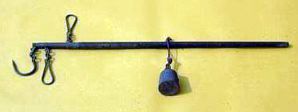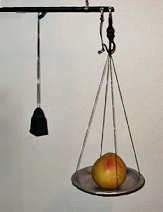A steelyard or "Roman Balance" (Chinese gănchèng 杆秤) is an instrument for weighing things. It consists of a horizontal balance bar suspended from a fulcrum, located towards one end, thus dividing the bar into a long and a short portion. From the short end a hook or weighing pan is suspended. The bar on the other side of the fulcrum is marked with calibration lines. A metal counterweight hanging from a loop of cord is slid back and forth along the balance bar until it exactly offsets what is being weighed. The weight may then be read from the calibration lines on the balance bar. (In principle, the weight of whatever is being weighed times the length of the short part of the balance bar equals weight the counterweight times its distance from the fulcrum.)

Steelyards were known across Eurasia by about 200 BC and have been used to weigh everything from livestock to tiny amounts of precious metals or ingredients for drugs. (Those used in traditional Chinese medicine are sometimes called "opium scales" in tourist English.)

From the beginning steelyards have been in competition with pan balances as weighing devices, and it is perhaps significant that pan balances have come to symbolize weighing throughout history. A pan balance, however, has two distinct disadvantages:
- An entire set of different size weights is required for the balance pan, while a steelyard requires only one.
- The pan balance is accurate only when the weights assembled exactly equal what is being weighed, whereas a steelyard weighs on a continuous scale.
The only obvious disadvantage of the steelyard is that until it has come into balance, there is a risk of the weight suddenly slipping off the stick or abruptly sliding to the fulcrum. This is easily controlled if the movement of the balance arm is limited by placing it in a frame, as in modern "doctors'scales."
